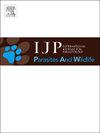罗马尼亚鼠耳螨寄主-寄生虫新关联及外寄生虫多样性研究
IF 2.2
3区 医学
Q3 ECOLOGY
International Journal for Parasitology-Parasites and Wildlife
Pub Date : 2025-05-20
DOI:10.1016/j.ijppaw.2025.101084
引用次数: 0
摘要
北白胸刺猬(Erinaceus roumanicus)是罗马尼亚广泛分布的物种,生活在多种环境中,包括与人类和家畜接触可能促进人畜共患病原体传播的城市地区。尽管它具有重要的生态意义,但罗马尼亚的外寄生动物群的数据仍然很少。本研究从生境类型、生物地理区域和季节特征等方面,对鼠背弓形虫的多样性、流行率和侵害模式进行了评估。对来自“Visul Luanei”野生动物康复中心的222只刺猬进行了体外寄生虫检查。其中53个样本用于寄生虫学分析,另外15个样本用于动物学评估。在68只被蜱感染的刺猬中,鉴定出5属12种1793只蜱。种类最多的是蓖麻伊蚊(Ixodes ricinus) (n = 1289;分别为71.91%、8.87%、8.81%、4.69%。蜱流行率为23.87% (95% CI: 18.74 ~ 29.90%),以草原地区最高(38.10%),自然生境最高(77.67±118.08只/人)。蜱虫活动高峰期为春季(32.63%);其他鉴定出的体外寄生虫包括蚤类(犬栉头虫、长春始祖虫)和螨类(秋新恙螨、三毛狼螨、长春蠕形螨)。值得注意的是,在罗马尼亚发现了三种新的寄主-寄生虫关联:图拉尼库蚊、三毛库蚊和白毛库蚊。这项研究首次全面描述了罗马尼亚鲁曼尼切鼠的外寄生虫动物群,强调了其作为与兽医和公共卫生相关的外寄生虫储存库的作用。这些发现支持在不断变化的环境中,将鲁马尼弓形虫作为监测外寄生虫多样性和人畜共患风险的前哨物种。本文章由计算机程序翻译,如有差异,请以英文原文为准。

New host-parasite associations and ectoparasite diversity of Erinaceus roumanicus in Romania
The northern white-breasted hedgehog (Erinaceus roumanicus) is a widely distributed species in Romania, inhabiting diverse environments, including urban areas where contact with humans and domestic animals may facilitate zoonotic pathogen circulation. Despite its ecological significance, data on its ectoparasitic fauna in Romania remain scarce. This study assessed the diversity, prevalence, and infestation patterns of ectoparasites in E. roumanicus, considering habitat type, biogeographical region, and seasonality. A total of 222 hedgehogs from the “Visul Luanei” Wildlife Rehabilitation Centre were examined for ectoparasites. Of these, 53 were included in parasitological analyses, while an additional 15 opportunistic samples contributed to faunistic assessments. Among the 68 tick-infested hedgehogs, 1793 ixodid ticks from 12 species across five genera were identified. The most abundant species were Ixodes ricinus (n = 1289; 71.91 %), I. redikorzevi (8.87 %), Rhipicephalus turanicus (8.81 %), and R. sanguineus (4.69 %). Tick prevalence was 23.87 % (95 % CI: 18.74–29.90 %), peaking in the Steppic region (38.10 %), with highest intensity in natural habitats (77.67 ± 118.08 ticks/host). Peak tick activity occurred in spring (32.63 %). Other identified ectoparasites included fleas (Ctenocephalides canis, Archaeopsylla erinacei s.l.) and mites (Neotrombicula autumnalis, Caparinia tripilis, Demodex erinacei). Notably, three new host–parasite associations were recorded in Romania: R. turanicus, C. tripilis, and D. erinacei. This study provides the first comprehensive characterization of the ectoparasite fauna of E. roumanicus in Romania, emphasizing its role as a reservoir of ectoparasites relevant to veterinary and public health. These findings support using E. roumanicus as a sentinel species for monitoring ectoparasite diversity and zoonotic risks in changing environments.
求助全文
通过发布文献求助,成功后即可免费获取论文全文。
去求助
来源期刊

International Journal for Parasitology-Parasites and Wildlife
Medicine-Infectious Diseases
CiteScore
3.80
自引率
5.60%
发文量
113
审稿时长
45 days
期刊介绍:
The International Journal for Parasitology: Parasites and Wildlife (IJP-PAW) publishes the results of original research on parasites of all wildlife, invertebrate and vertebrate. This includes free-ranging, wild populations, as well as captive wildlife, semi-domesticated species (e.g. reindeer) and farmed populations of recently domesticated or wild-captured species (e.g. cultured fishes). Articles on all aspects of wildlife parasitology are welcomed including taxonomy, biodiversity and distribution, ecology and epidemiology, population biology and host-parasite relationships. The impact of parasites on the health and conservation of wildlife is seen as an important area covered by the journal especially the potential role of environmental factors, for example climate. Also important to the journal is ''one health'' and the nature of interactions between wildlife, people and domestic animals, including disease emergence and zoonoses.
 求助内容:
求助内容: 应助结果提醒方式:
应助结果提醒方式:


